Yes that's right, pink sand! The prospect of visiting Zamboanga City's pink sand beach – Great Santa Cruz Island – was more than enough reason to hope that the rains that had been pouring down on the city would stop even for a brief moment. Zamboanga Hermosa, the city's fiesta, and rain come hand in hand. But they say when the image of the Nuestra Señora del Pilar is brought out for her procession, the skies clear up. I was hoping the skies would clear up for our trip too!
Showing posts with label Zamboanga. Show all posts
Showing posts with label Zamboanga. Show all posts
Tuesday, December 09, 2014
Friday, September 10, 2010
Zamboanga: Satti at Pilar Street and Canelar Street

Satti is an early morning dish sold in Zamboanga City. It's actually from Jolo, Sulu but was made popular in Zamboanga City. It was a good thing satti restaurants open as early as 4 a.m. in Pilar Street. So as soon as I arrived from Jolo, I went straight there for breakfast.

For an affordable Php50, you get eight sticks of beef satti and puso (rice) floating in a generous serving of the sweet and spicy sauce that accompanies the satti. There's also chicken satti and you can pick which chicken part you want. In one corner of the restaurant, one of the staff was slicing puso into small pieces preparing them in bowls where the satti and sauce would be added later.

Pilar Street has a lot of satti restaurants. But there's actually another satti place in Canelar Street if you're staying in a hotel near the airport. It's very close to Jollibee. Just make sure you visit in the morning since supply doesn't last until the evening.
Now I'm craving for satti! Does anyone know where to get satti in Metro Manila?
Tuesday, September 07, 2010
Sulu: Visiting Jolo, Bud Datu in Indanan and Quezon Beach in Patikul
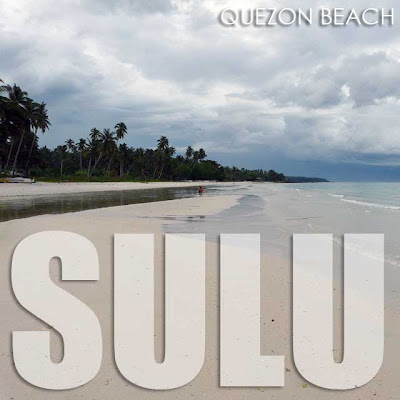
Sulu is indeed an island paradise. It's so unfortunate that the security situation there won't allow tourist arrivals for the meantime. But my curiosity pushed me to visit the island and see what was there. You can get to Jolo, Sulu from Zamboanga City since ferries leave Zamboanga Port every evening and arrive in Jolo at about four in the morning.
I spent Php620 for a cabin room bed (a cabin room accommodates four people). The regular aircon beds are Php470 which are all in one hallway. The cabin rooms have doors which you could lock. There are also flights to Jolo available from Zamboanga. Read Day-trip to Jolo for Part 1 of this trip.

After my quick nap, we proceeded to explore Jolo and the neighboring towns of Patikul and Indanan. We first dropped by the Sulu Provincial Capitol in Jolo. I noticed the centuries-old trees that lined the avenue that led to the Sulu Capitol. How I wish many of our old cities were able to preserve their trees.
You could also see the vernacular architecture hidden under the urban chaos of Jolo. If only the politicians there had the political will to clean up the city and preserve its character, Jolo would have been an even more fascinating town.
It's the gold domes that stand out in the Sulu Provincial Capitol. Beside the Sulu Capitol is the National Museum Sulu Branch which houses historical and cultural artifacts and exhibits on Sulu including the Sultanate of Sulu, as well as the Tausug and Badjao among others.
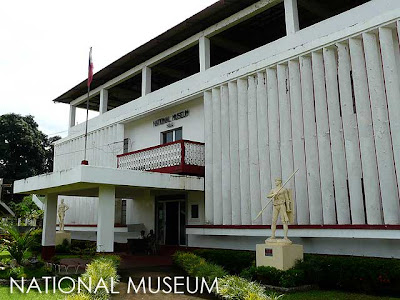
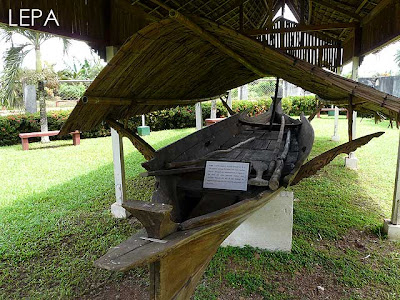
Outside the main building are statues of local heroes Panglima Unaid and Abduhalim Imao, as well as a century-old Bajau houseboat called a lepa.


I also got to taste the local Sulu variety of durian which was really good. And the prices shocked me. A basket of lansones (which looked like almost 8 kilos) was just Php70 or less than Php10 a kilo! The durian was just Php30 a piece or roughly Php15 a kilo. A bundle of mangosteen was just Php20 and my host told me that when in season, you could buy mangosteen for as low as Php5 a kilo!

We then visited the Central Mosque in Jolo. Unfortunately, I could only take a photo from the outside. There were a lot of people exiting the mosque since Friday prayers had just finished.

Lunch and the early afternoon was spent indoors since it started raining really hard. I walked to the nearby Jolo Cathedral when the rain stopped. In front of it was a Rizal Monument.
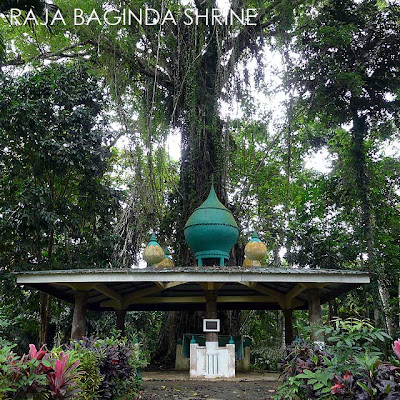

Later in the afternoon, we motored to the town of Indanan to visit Bud Datu where the grave of Raja Baginda, the first Muslim ruler of Sulu, is located. You'll have to enter a military camp to reach it. And since it's in a military camp, it's relatively well-maintained. But I'm sure the Raja Baginda Shrine can be improved to highlight the prominence of this Sulu pioneer in our nation's history. In fact, I'm surprised the National Historical Commission hasn't placed a marker there yet.
You can also see a nice panoramic view of Jolo from Bud Datu. But unfortunately, as we were walking from the Rajah Baginda Shrine to our vehicle, the sun disappeared again and it started to rain. So we ditched the view.

We had to wait the rain out again before proceeding to our last stop, said to be one of the best beaches in the Philippines with a wide expanse of white sand that could rival that of Boracay. It was about twelve kilometers from Jolo in the town of Patikul. Quezon Beach was highly-recommended with a caveat though: that I may need a security escort to visit.
My hosts didn't mention any of that so we proceeded to Quezon Beach. We passed by several military camps and check points along the road that went deeper into Patikul. I noticed the houses, very fine examples of vernacular architecture. They rarely used hollow blocks in Patikul. And I felt I entered a time warp as we drove through since these could have been the architecture of Maynilad when the Spaniards arrived there almost five centuries ago. Most of the wooden houses were elevated on stilts with covered porches on two sides. An elevated walkway connected the main house to another structure behind the house which served as a kitchen and cleaning area.

We finally reached Barangay Igasan and parked by the beach. There wasn't too much sun. But I could see that the beach was stunning even with the overcast skies. The beach was wide and the water was baby blue. I was told that further down the road, the sand was even finer, powder fine in fact to rival the best beaches of the country. But I had to save it for another day. I did not want to push my luck any further since it was starting to get dark. The sun and sand would have been an impeccable combination. But I guess I'll have to wait for another trip, hopefully when the situation is a bit better.
What I liked about the beach was that the houses were all made of native materials. So it really gave you that tropical feel. At least for now, it will stay that way. But I wonder how they would manage development there if the situation gets better.
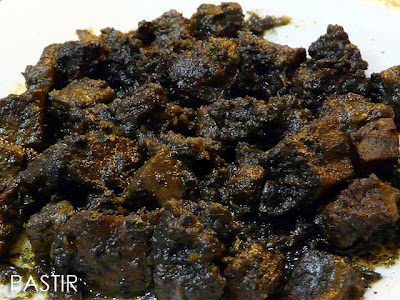

Back in Jolo, we had dinner and I got to try more local meat dishes like pastir and pyesak. Relatives of my host, curious as to where I went, asked which places I visited. When I told them we came from Quezon Beach, I got startled reactions. One even asked my host if they really brought me there and said I was brave to even visit. It was only then that I found out that the area was where many of the kidnappings this year occurred.
After dinner, I was brought to the Jolo Port to catch the 8 p.m. ferry back to Zamboanga. It was the M.V. Kristel Jane 3 again and I got myself the same cabin room. I was back in Zamboanga City at 4 a.m. just in time for another satti breakfast. As soon as I was done, I rushed to the transport terminal in Guiwan to catch a bus to Pagadian.
Monday, November 10, 2008
Zamboanga: Zamboanga City's colorful heritage
 One thing I get to enjoy attending all these out-of-town conferences is that I get to explore the place after. So before flying back to Manila, we made sure to visit (revisit in some cases) the different cultural attractions of Zamboanga City. The cultural fabric of Asia's Latin City is evindently intact and one call definitely feel Zambaonga's spirit of place as we went around the city.
One thing I get to enjoy attending all these out-of-town conferences is that I get to explore the place after. So before flying back to Manila, we made sure to visit (revisit in some cases) the different cultural attractions of Zamboanga City. The cultural fabric of Asia's Latin City is evindently intact and one call definitely feel Zambaonga's spirit of place as we went around the city. After visiting a Gabaldon school building restored by the City Government of Zamboanga, we visited the Western Mindanao State University where an outstanding example of a building designed by Juan Arellano stands. It is arguably one of the best Arellano buildings in the country. And it's silently stands in the heart of Zamboanga City!
After visiting a Gabaldon school building restored by the City Government of Zamboanga, we visited the Western Mindanao State University where an outstanding example of a building designed by Juan Arellano stands. It is arguably one of the best Arellano buildings in the country. And it's silently stands in the heart of Zamboanga City!As Archt. Toti Villalon mentions in his column, "More outstanding than anything I saw in Zamboanga is the main building of Western Mindanao State University. An undiscovered gem of American colonial architecture from the early 20th century, it is a wonderful example of Beaux Arts favored by the American colonial government, which was adapted to tropical conditions with large window openings, high ceilings with floor-through interior ventilation and excellent architectural craftsmanship in its moldings, doors and wrought-iron grillwork."
We also dropped by the local hospital which was of the hospital pavilion layout that was popular during the American colonial period, the PGH design that became the standard for American hospitals in tropical areas.

 From there, we proceeded to Plaza Pershing. We requested Mayor Lobregat to keep the grass and avoid placing pavers since the park is a fine example of public parks during the American colonial period.
From there, we proceeded to Plaza Pershing. We requested Mayor Lobregat to keep the grass and avoid placing pavers since the park is a fine example of public parks during the American colonial period.From there we walked to Zamboanga City Hall. Our guide, at the request of the mayor, treated us to his rendition of Rizal's El Ultimo Adios right in front of the Rizal Monument.
After a tour of city hall, our group proceeded to Fort Pilar, which is a national cultural treasure, before proceeding to the Barter Market to do some shopping.
 The Barter Market is a great place to get textiles both local and imported. It's a good place to buy batik and Arafat scarves (if you bargain well, you can get one for PHP75 or even lower). In fact, you'll see a good number of Malaysian and Indonesian products such as instant noodles, candies and other items.
The Barter Market is a great place to get textiles both local and imported. It's a good place to buy batik and Arafat scarves (if you bargain well, you can get one for PHP75 or even lower). In fact, you'll see a good number of Malaysian and Indonesian products such as instant noodles, candies and other items. Our last stop for the morning was the Yakan Weaving Village where one could purchase fine examples of Yakan woven products. Also available there are banig from Sulu and other woven items from the nearby Muslim provinces. If you're lucky, you can watch the women weave cloth.
Our last stop for the morning was the Yakan Weaving Village where one could purchase fine examples of Yakan woven products. Also available there are banig from Sulu and other woven items from the nearby Muslim provinces. If you're lucky, you can watch the women weave cloth. For lunch, we proceeded to a Malaysian mamak in Zamboanga! It was among my favorite eating places the last time I was in Zamboanga and I made sure we stopped at Tini's before going home. As always, I ordered roti telur and murtabak. But I think the curry sauce in Malaysia is still best.
For lunch, we proceeded to a Malaysian mamak in Zamboanga! It was among my favorite eating places the last time I was in Zamboanga and I made sure we stopped at Tini's before going home. As always, I ordered roti telur and murtabak. But I think the curry sauce in Malaysia is still best.In the afternoon, we visited the Gabaldon school in the Mercedes District and the Taluksangay Mosque. The school is intact but the mosque is not. In just two years, the historical fabric of the mosque had been destroyed by unguided renovations. There was a really nice view of the mosque from the river. But that image is now gone with the roof they placed to cover the entire grounds of the mosque. Sad to say, the mosque had a marker of the NHI. I wonder how it got renovated.
Part 1: Another Zamboanga City adventure
Part 2: Seafood in Zamboanga City at Alavar's Restaurant
Related posts
Hola Zamboanga!
Sta. Cruz Island and its pink sand
Off the beaten track in Basilan
Sunday, November 09, 2008
Zamboanga: Seafood in Zamboanga City at Alavar's Restaurant
 I'm not a seafood person but I know for a fact that Zamboanga City takes pride in its seafood restaurants. I've always heard about Alavar's Restaurant and it was great that Mayor Celso Lobregat decided to host dinner for us there.
I'm not a seafood person but I know for a fact that Zamboanga City takes pride in its seafood restaurants. I've always heard about Alavar's Restaurant and it was great that Mayor Celso Lobregat decided to host dinner for us there. They served us so much! One of their best sellers would be the curacha with Alavar's sauce (curacha con salsa Alavar's). Curacha is a species of crab abundant in Zamboanga waters.
They served us so much! One of their best sellers would be the curacha with Alavar's sauce (curacha con salsa Alavar's). Curacha is a species of crab abundant in Zamboanga waters.I particularly enjoyed the grilled imbao with garlic and butter and the seafood paella. But since I am not a seafood person, I was content with the crispy pata and found myself stuffed to the brim.
Alavar's Restaurant
Don Alfaro Street, Tetuan, Zamboanga City
Part 1: Another Zamboanga City adventure
Part 3: Zamboanga City's colorful heritage
Related posts
Hola Zamboanga!
Sta. Cruz Island and its pink sand
Off the beaten track in Basilan
Saturday, November 08, 2008
Zamboanga: Another Zamboanga City adventure
 I was in Zamboanga City again to attend the 3rd Philippine Towns & Cities Conference organized by the Heritage Conservation Society. I had actually arrived two days before but decided to make a side trip to Bongao, Tawi-Tawi since SEAIR conveniently flies there (the fast craft would take several hours). The conference was at the Garden Orchid Hotel which was quite close to the airport. Tired from the trip, I decided to rest the whole afternoon.
I was in Zamboanga City again to attend the 3rd Philippine Towns & Cities Conference organized by the Heritage Conservation Society. I had actually arrived two days before but decided to make a side trip to Bongao, Tawi-Tawi since SEAIR conveniently flies there (the fast craft would take several hours). The conference was at the Garden Orchid Hotel which was quite close to the airport. Tired from the trip, I decided to rest the whole afternoon. The program began in the evening with a Welcome Reception hosted by the City Government of Zamboanga. Indeed, it was a fitting welcome to Asia's Latin City. A choir serenaded us with songs in Spanish and the local Chavacano reminding us that Zamboanga City is a living manifestation of Spanish cultural influences in the Philippines.
The program began in the evening with a Welcome Reception hosted by the City Government of Zamboanga. Indeed, it was a fitting welcome to Asia's Latin City. A choir serenaded us with songs in Spanish and the local Chavacano reminding us that Zamboanga City is a living manifestation of Spanish cultural influences in the Philippines.After the reception, our gracious host, Mayor Celso Lobregat, took us the the Fort Pilar Shrine since he said it was nice there in the evening. The Fort Pilar Shrine is an open-air church on one side of the fort. There were still a good number of devotees there lighting candles by one of the walls of the fort.
Mayor Lobregat was very generous and he bought us several candles from the vendors. After going around the shrine, we chanced upon a vendor selling the local crispy wafers and he bought everything and gave one to anyone and everyone he saw there, our group included.
 We made one last stop in Climaco corner Lim Avenue since Mayor Lobregat wanted to show us an unusual phenomenon that happens in the area in the evening. Perched on the electric wires covering several blocks were thousands of birds nearly equidistant from each other. He said it happens every night. They arrive at a certain time when the sun sets and leave at the same time during the sunrise.
We made one last stop in Climaco corner Lim Avenue since Mayor Lobregat wanted to show us an unusual phenomenon that happens in the area in the evening. Perched on the electric wires covering several blocks were thousands of birds nearly equidistant from each other. He said it happens every night. They arrive at a certain time when the sun sets and leave at the same time during the sunrise. I was the first to wake up the next morning since I wanted to get myself a serving of Zamboanga City's morning dish, satti! Similar to the traditional Malay satay, satti is native to the Moro people of Mindanao. In Zamboanga, these are small pieces of beef roasted in a skewer. The sticks of satti are served submerged in a bowl of sweet and spicy sauce with puso or ta'mu also in a bowl of the same sauce. Puso is basically the Malay ketupat, rice that is cooked inside a palm leaf pouch.
I was the first to wake up the next morning since I wanted to get myself a serving of Zamboanga City's morning dish, satti! Similar to the traditional Malay satay, satti is native to the Moro people of Mindanao. In Zamboanga, these are small pieces of beef roasted in a skewer. The sticks of satti are served submerged in a bowl of sweet and spicy sauce with puso or ta'mu also in a bowl of the same sauce. Puso is basically the Malay ketupat, rice that is cooked inside a palm leaf pouch.Anyway, after that hearty breakfast, I had to rush back to the hotel to get ready for the conference since I was the master of ceremonies today.
Part 2: Seafood in Zamboanga City at Alavar's Restaurant
Part 3: Zamboanga City's colorful heritage
Related posts
Hola Zamboanga!
Sta. Cruz Island and its pink sand
Off the beaten track in Basilan
Tuesday, August 08, 2006
Zamboanga: Santa Cruz Island and its pink sand
And now, for the final installment of my recent trip is my visit to the Great and Little Santa Cruz Island Protected Landscapes and Seascapes. I had booked my trip with the DOT regional office. I could have opted to go on my own but that would mean paying for the entire boat. So I kept my fingers crossed hoping that a group would leave Sunday, and that they would allow me to tag along. Good thing there was a group of local teachers and students who booked a trip while I was in the office.
 So I was up early to make sure I made the 7 a.m. call time. There was still no sign of the group at 7:15 a.m. so that got me worried. Until finally someone had approached me asking if I was the one who was going to tag along. It turned out, the group had two designated meeting places. And the bigger group which was at the pier was gone before the organizer had arrived. To make things worse, there were just three of us at Lantaka Hotel, myself, the organizer and a student.
So I was up early to make sure I made the 7 a.m. call time. There was still no sign of the group at 7:15 a.m. so that got me worried. Until finally someone had approached me asking if I was the one who was going to tag along. It turned out, the group had two designated meeting places. And the bigger group which was at the pier was gone before the organizer had arrived. To make things worse, there were just three of us at Lantaka Hotel, myself, the organizer and a student.
 After waiting for sometime, we decided to check again at the pier. We would later find out when we got to the island that the group which met at the pier, after seeing the rough waves which were a result of the tail end of "Inday," had backed out! Anyway, after some haggling with the boat owner, we were able to bring down the cost thanks to our appeal to pity.
After waiting for sometime, we decided to check again at the pier. We would later find out when we got to the island that the group which met at the pier, after seeing the rough waves which were a result of the tail end of "Inday," had backed out! Anyway, after some haggling with the boat owner, we were able to bring down the cost thanks to our appeal to pity.
So the three of us made the trip to Santa Cruz despite the rough seas. And I was tense for the most part as our boat made the slow trip to the island, rocked by strong waves. I was actually praying for sunshine. We got there in one piece. And for some twist of fate, the sun did come out a few minutes after we arrived on Great Santa Cruz Island.
 The two islands which are a few meters away from each other, and the waters that surround it form the Great and Little Santa Cruz Island Protected Landscapes and Seascapes. Both islands often play host to environmental activities with students from local universities such as Ateneo de Zamboanga organizing tree-planting activities and coastal clean-ups. There are just about forty families which live on the island, all from the Samal tribe which was allowed to stay in the protected area.
The two islands which are a few meters away from each other, and the waters that surround it form the Great and Little Santa Cruz Island Protected Landscapes and Seascapes. Both islands often play host to environmental activities with students from local universities such as Ateneo de Zamboanga organizing tree-planting activities and coastal clean-ups. There are just about forty families which live on the island, all from the Samal tribe which was allowed to stay in the protected area.
What makes the sand on the island unique is its distinct pink color which is a result of tiny pink coral fragments mixed with the white sand. For a close up of the sand, click here. And just like in Malamawi White Beach, I had the beach all to myself! We learned from the locals there that even before Puerto Galera and Boracay, Santa Cruz was a popular destination among tourists. But after the spate of abductions and kidnappings many years back, its popularity waned.
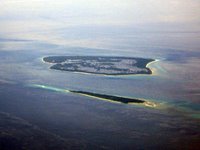 Anyway, after a brief dip in the blue water, I decided to walk around the island. It would take two hours to walk around from end to end. So I just hiked a few meters to check out the other side. As you can see from an aerial photo which I took from the plane, the center of the island was mostly mangrove swamps and a lagoon.
Anyway, after a brief dip in the blue water, I decided to walk around the island. It would take two hours to walk around from end to end. So I just hiked a few meters to check out the other side. As you can see from an aerial photo which I took from the plane, the center of the island was mostly mangrove swamps and a lagoon.
We went back to downtown Zamboanga at about 12 noon and this time, the water was calmer. But I had a worse headache than the day before. Again, I decided to eat at Tini's where I ordered murtabak daging (beef prata) and roti kosong (flour pancake). Then I walked back to the pension house to freshen up and take a quick nap. I made sure not to sleep too long since I wanted to visit as much as I could during my last 24 hours in Zamboanga City.
 Next on my itinerary was a trip to Mt. Pulong Bato in Barangay Abong Abong from where visitors are rewarded with a breathtaking view of Zamboanga City and the outlying islands. From downtown, I took a jeep to Abong Abong via Pasonanca which was just PHP10. Make sure you mention to the driver that you want to visit the stations of the cross so that he could drop you off at the foot of the mountain. I was dropped off at a place called canyon or Freedom Park which had some military relics, large guns in particular hence the moniker canyon, and a tomb for an unknown soldier.
Next on my itinerary was a trip to Mt. Pulong Bato in Barangay Abong Abong from where visitors are rewarded with a breathtaking view of Zamboanga City and the outlying islands. From downtown, I took a jeep to Abong Abong via Pasonanca which was just PHP10. Make sure you mention to the driver that you want to visit the stations of the cross so that he could drop you off at the foot of the mountain. I was dropped off at a place called canyon or Freedom Park which had some military relics, large guns in particular hence the moniker canyon, and a tomb for an unknown soldier.
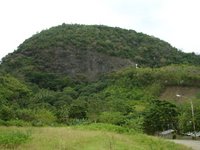 I thus ended up walking an extra 1.5 kilometers to the foot of the mountain, not including the 750 meter steep climb to the vantage point. On the way up were bas relief murals of the fourteen stations of the cross. That was really exhausting! But the view from on top was worth the climb. Since the road is well paved, you can drive a vehicle up as well.
I thus ended up walking an extra 1.5 kilometers to the foot of the mountain, not including the 750 meter steep climb to the vantage point. On the way up were bas relief murals of the fourteen stations of the cross. That was really exhausting! But the view from on top was worth the climb. Since the road is well paved, you can drive a vehicle up as well.
 It was about 3:30 p.m. and I had to rush down and back to downtown since I had one more destination on my itinerary, the oldest mosque in Zamboanga in Barangay Taluksangay. People had warned me that it was going to be far but that did not hinder me. So as soon as I got back to downtown, I immediately boarded a jeep to the Muslim community of Taluksangay near the Mercedes District. It was about 17 kilometers away and the fare was PHP20.
It was about 3:30 p.m. and I had to rush down and back to downtown since I had one more destination on my itinerary, the oldest mosque in Zamboanga in Barangay Taluksangay. People had warned me that it was going to be far but that did not hinder me. So as soon as I got back to downtown, I immediately boarded a jeep to the Muslim community of Taluksangay near the Mercedes District. It was about 17 kilometers away and the fare was PHP20.
I arrived there at 5 p.m. just before the sun went down. I was happy to see a marker of the National Historical Institute which emphasized the significance of the site to our nation's history.
 As I mentioned earlier, this was the first mosque in the Zamboanga Peninsula. Built by Hadji Abdullah Maas Nuno in 1885, it was the first center of Islam which was recognized by the international Islamic community.
As I mentioned earlier, this was the first mosque in the Zamboanga Peninsula. Built by Hadji Abdullah Maas Nuno in 1885, it was the first center of Islam which was recognized by the international Islamic community.
Anyway, going back to downtown Zamboanga City was going to be a problem since the jeepney driver had mentioned me that there were no more trips back. So from Taluksangay, I took a pedicab to the next barangay which was Talabaan where motorcycles-for-hire were waiting to take me back to the highway. The trip was PHP30 and I agreed since I would be able to stopover at the Gabaldon buildings in the Mercedes Central School. I was surprised to see many of the buildings intact. Aside from the main building, the original home economics and industrial arts buildings were still standing.
From the highway, I took a jeep back to downtown. The good thing about the public transport system in Zamboanga City is that all jeepneys travel to the downtown area so you can easily find you way around. I got off at St. Joseph's Church to hear Mass. The church was air-conditioned which was a welcome feeling after a humid and tiring day.
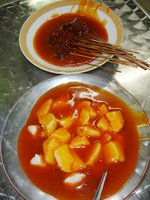 After Mass, my plan was to check out those satti outlets again. It was just 7 p.m. and I was surprised to see all of them closed! So I asked a tricycle driver to take me to the nearest sattihan. The driver mentioned to me that those were the only ones he knew. And that the reason they closed early was because they were open as early as 4 a.m. So that's why! It turns out satti was a breakfast dish in Zamboanga.
After Mass, my plan was to check out those satti outlets again. It was just 7 p.m. and I was surprised to see all of them closed! So I asked a tricycle driver to take me to the nearest sattihan. The driver mentioned to me that those were the only ones he knew. And that the reason they closed early was because they were open as early as 4 a.m. So that's why! It turns out satti was a breakfast dish in Zamboanga.
Anyway, I went back to Tini's for dinner since this was the last chance I could eat roti in a long time. And I made sure I went to bed early since my plan was to savor the elusive satti before I left on the 9:55 a.m. flight. I was up at 6 a.m. and finally, I was able to treat myself to satti! As I mentioned in a previous post, these were three small pieces of roasted beef on a barbeque stick dipped in a bowl of sweet and spicy sauce served with rice floating in another plate of the same sauce. Each was PHP3.50 and the rice was something like PHP8 per serving (if you remember the rice I had in Larsian which I mentioned in my Cebu entry, it was the same one).
I then went back to the pension house to take a quick nap. After checking out, I took a tricycle to the airport for PHP30. I was quite early for the flight but it was better to be there early than to be left behind. Good thing there was a massage service there so I got myself relaxed before boarding.
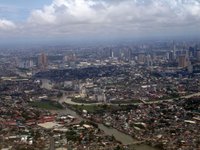 One thing I liked about the experience at the airport was that everyone on the runway, from the ground crew to the security guards waved at the plane as it left the tarmac. It was a very heartwarming experience for passengers looking out the windows.
One thing I liked about the experience at the airport was that everyone on the runway, from the ground crew to the security guards waved at the plane as it left the tarmac. It was a very heartwarming experience for passengers looking out the windows.
I took a lot of photos on the plane as well. Here are two of them. The first is the Ortigas area with the Pasig River and the old Rizal Provincial Capitol in the green open space along the river close to the center of the photo. The bridge you see is the C5 Bridge.
 The second photo is Makati with the Fort Bonifacio Global City and American Cemetery in the foreground. I guess that's it for now. Until the next trip.
The second photo is Makati with the Fort Bonifacio Global City and American Cemetery in the foreground. I guess that's it for now. Until the next trip.
 So I was up early to make sure I made the 7 a.m. call time. There was still no sign of the group at 7:15 a.m. so that got me worried. Until finally someone had approached me asking if I was the one who was going to tag along. It turned out, the group had two designated meeting places. And the bigger group which was at the pier was gone before the organizer had arrived. To make things worse, there were just three of us at Lantaka Hotel, myself, the organizer and a student.
So I was up early to make sure I made the 7 a.m. call time. There was still no sign of the group at 7:15 a.m. so that got me worried. Until finally someone had approached me asking if I was the one who was going to tag along. It turned out, the group had two designated meeting places. And the bigger group which was at the pier was gone before the organizer had arrived. To make things worse, there were just three of us at Lantaka Hotel, myself, the organizer and a student. After waiting for sometime, we decided to check again at the pier. We would later find out when we got to the island that the group which met at the pier, after seeing the rough waves which were a result of the tail end of "Inday," had backed out! Anyway, after some haggling with the boat owner, we were able to bring down the cost thanks to our appeal to pity.
After waiting for sometime, we decided to check again at the pier. We would later find out when we got to the island that the group which met at the pier, after seeing the rough waves which were a result of the tail end of "Inday," had backed out! Anyway, after some haggling with the boat owner, we were able to bring down the cost thanks to our appeal to pity.So the three of us made the trip to Santa Cruz despite the rough seas. And I was tense for the most part as our boat made the slow trip to the island, rocked by strong waves. I was actually praying for sunshine. We got there in one piece. And for some twist of fate, the sun did come out a few minutes after we arrived on Great Santa Cruz Island.
 The two islands which are a few meters away from each other, and the waters that surround it form the Great and Little Santa Cruz Island Protected Landscapes and Seascapes. Both islands often play host to environmental activities with students from local universities such as Ateneo de Zamboanga organizing tree-planting activities and coastal clean-ups. There are just about forty families which live on the island, all from the Samal tribe which was allowed to stay in the protected area.
The two islands which are a few meters away from each other, and the waters that surround it form the Great and Little Santa Cruz Island Protected Landscapes and Seascapes. Both islands often play host to environmental activities with students from local universities such as Ateneo de Zamboanga organizing tree-planting activities and coastal clean-ups. There are just about forty families which live on the island, all from the Samal tribe which was allowed to stay in the protected area.What makes the sand on the island unique is its distinct pink color which is a result of tiny pink coral fragments mixed with the white sand. For a close up of the sand, click here. And just like in Malamawi White Beach, I had the beach all to myself! We learned from the locals there that even before Puerto Galera and Boracay, Santa Cruz was a popular destination among tourists. But after the spate of abductions and kidnappings many years back, its popularity waned.
 Anyway, after a brief dip in the blue water, I decided to walk around the island. It would take two hours to walk around from end to end. So I just hiked a few meters to check out the other side. As you can see from an aerial photo which I took from the plane, the center of the island was mostly mangrove swamps and a lagoon.
Anyway, after a brief dip in the blue water, I decided to walk around the island. It would take two hours to walk around from end to end. So I just hiked a few meters to check out the other side. As you can see from an aerial photo which I took from the plane, the center of the island was mostly mangrove swamps and a lagoon.We went back to downtown Zamboanga at about 12 noon and this time, the water was calmer. But I had a worse headache than the day before. Again, I decided to eat at Tini's where I ordered murtabak daging (beef prata) and roti kosong (flour pancake). Then I walked back to the pension house to freshen up and take a quick nap. I made sure not to sleep too long since I wanted to visit as much as I could during my last 24 hours in Zamboanga City.
 Next on my itinerary was a trip to Mt. Pulong Bato in Barangay Abong Abong from where visitors are rewarded with a breathtaking view of Zamboanga City and the outlying islands. From downtown, I took a jeep to Abong Abong via Pasonanca which was just PHP10. Make sure you mention to the driver that you want to visit the stations of the cross so that he could drop you off at the foot of the mountain. I was dropped off at a place called canyon or Freedom Park which had some military relics, large guns in particular hence the moniker canyon, and a tomb for an unknown soldier.
Next on my itinerary was a trip to Mt. Pulong Bato in Barangay Abong Abong from where visitors are rewarded with a breathtaking view of Zamboanga City and the outlying islands. From downtown, I took a jeep to Abong Abong via Pasonanca which was just PHP10. Make sure you mention to the driver that you want to visit the stations of the cross so that he could drop you off at the foot of the mountain. I was dropped off at a place called canyon or Freedom Park which had some military relics, large guns in particular hence the moniker canyon, and a tomb for an unknown soldier. I thus ended up walking an extra 1.5 kilometers to the foot of the mountain, not including the 750 meter steep climb to the vantage point. On the way up were bas relief murals of the fourteen stations of the cross. That was really exhausting! But the view from on top was worth the climb. Since the road is well paved, you can drive a vehicle up as well.
I thus ended up walking an extra 1.5 kilometers to the foot of the mountain, not including the 750 meter steep climb to the vantage point. On the way up were bas relief murals of the fourteen stations of the cross. That was really exhausting! But the view from on top was worth the climb. Since the road is well paved, you can drive a vehicle up as well. It was about 3:30 p.m. and I had to rush down and back to downtown since I had one more destination on my itinerary, the oldest mosque in Zamboanga in Barangay Taluksangay. People had warned me that it was going to be far but that did not hinder me. So as soon as I got back to downtown, I immediately boarded a jeep to the Muslim community of Taluksangay near the Mercedes District. It was about 17 kilometers away and the fare was PHP20.
It was about 3:30 p.m. and I had to rush down and back to downtown since I had one more destination on my itinerary, the oldest mosque in Zamboanga in Barangay Taluksangay. People had warned me that it was going to be far but that did not hinder me. So as soon as I got back to downtown, I immediately boarded a jeep to the Muslim community of Taluksangay near the Mercedes District. It was about 17 kilometers away and the fare was PHP20.I arrived there at 5 p.m. just before the sun went down. I was happy to see a marker of the National Historical Institute which emphasized the significance of the site to our nation's history.
 As I mentioned earlier, this was the first mosque in the Zamboanga Peninsula. Built by Hadji Abdullah Maas Nuno in 1885, it was the first center of Islam which was recognized by the international Islamic community.
As I mentioned earlier, this was the first mosque in the Zamboanga Peninsula. Built by Hadji Abdullah Maas Nuno in 1885, it was the first center of Islam which was recognized by the international Islamic community.Anyway, going back to downtown Zamboanga City was going to be a problem since the jeepney driver had mentioned me that there were no more trips back. So from Taluksangay, I took a pedicab to the next barangay which was Talabaan where motorcycles-for-hire were waiting to take me back to the highway. The trip was PHP30 and I agreed since I would be able to stopover at the Gabaldon buildings in the Mercedes Central School. I was surprised to see many of the buildings intact. Aside from the main building, the original home economics and industrial arts buildings were still standing.
From the highway, I took a jeep back to downtown. The good thing about the public transport system in Zamboanga City is that all jeepneys travel to the downtown area so you can easily find you way around. I got off at St. Joseph's Church to hear Mass. The church was air-conditioned which was a welcome feeling after a humid and tiring day.
 After Mass, my plan was to check out those satti outlets again. It was just 7 p.m. and I was surprised to see all of them closed! So I asked a tricycle driver to take me to the nearest sattihan. The driver mentioned to me that those were the only ones he knew. And that the reason they closed early was because they were open as early as 4 a.m. So that's why! It turns out satti was a breakfast dish in Zamboanga.
After Mass, my plan was to check out those satti outlets again. It was just 7 p.m. and I was surprised to see all of them closed! So I asked a tricycle driver to take me to the nearest sattihan. The driver mentioned to me that those were the only ones he knew. And that the reason they closed early was because they were open as early as 4 a.m. So that's why! It turns out satti was a breakfast dish in Zamboanga.Anyway, I went back to Tini's for dinner since this was the last chance I could eat roti in a long time. And I made sure I went to bed early since my plan was to savor the elusive satti before I left on the 9:55 a.m. flight. I was up at 6 a.m. and finally, I was able to treat myself to satti! As I mentioned in a previous post, these were three small pieces of roasted beef on a barbeque stick dipped in a bowl of sweet and spicy sauce served with rice floating in another plate of the same sauce. Each was PHP3.50 and the rice was something like PHP8 per serving (if you remember the rice I had in Larsian which I mentioned in my Cebu entry, it was the same one).
I then went back to the pension house to take a quick nap. After checking out, I took a tricycle to the airport for PHP30. I was quite early for the flight but it was better to be there early than to be left behind. Good thing there was a massage service there so I got myself relaxed before boarding.
 One thing I liked about the experience at the airport was that everyone on the runway, from the ground crew to the security guards waved at the plane as it left the tarmac. It was a very heartwarming experience for passengers looking out the windows.
One thing I liked about the experience at the airport was that everyone on the runway, from the ground crew to the security guards waved at the plane as it left the tarmac. It was a very heartwarming experience for passengers looking out the windows.I took a lot of photos on the plane as well. Here are two of them. The first is the Ortigas area with the Pasig River and the old Rizal Provincial Capitol in the green open space along the river close to the center of the photo. The bridge you see is the C5 Bridge.
 The second photo is Makati with the Fort Bonifacio Global City and American Cemetery in the foreground. I guess that's it for now. Until the next trip.
The second photo is Makati with the Fort Bonifacio Global City and American Cemetery in the foreground. I guess that's it for now. Until the next trip.
Subscribe to:
Posts (Atom)

